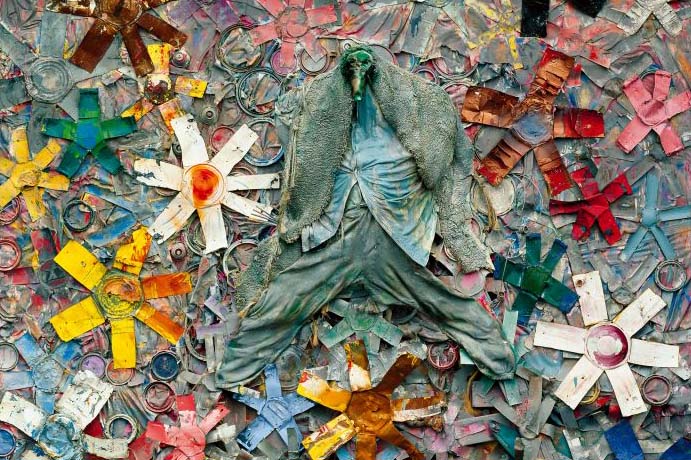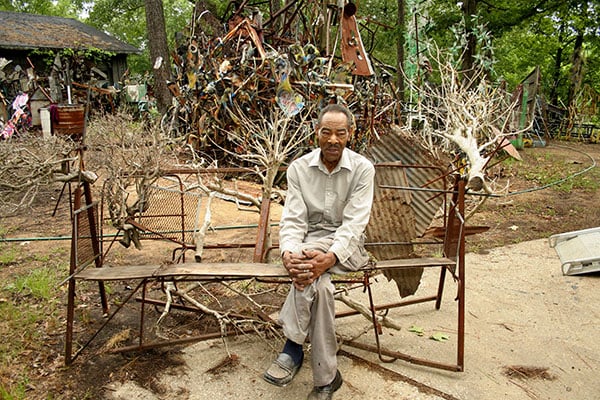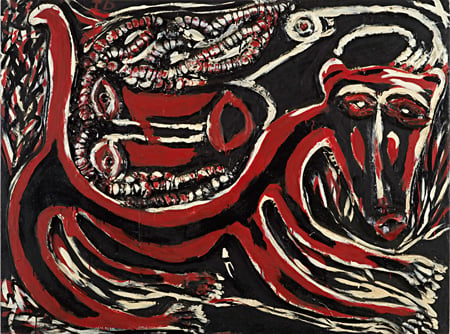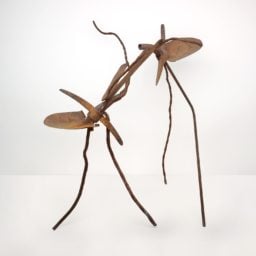

Thornton Dial, a prominent outsider artist from Emelle, Alabama, is dead at 87, the Associated Press reports. Dial had previously suffered from numerous strokes, but the cause of death has not yet been identified.
Born to African American sharecroppers in 1928, Dial was self-taught as an artist, creating paintings and sculptures from found materials like sail cloth, wire, and discarded doll parts. He rose to prominence in 1987 thanks to collector Bill Arnett, who later founded the Souls Grown Deep Foundation, an organization dedicated to promoting self-taught African American artists.
In a statement, Arnett recalls first discovering Dial’s work, which the artist had been storing inside a chicken coop: “I didn’t know at the time that it wasn’t simply the sculpture that was special. The man who had created it was a great man, and he would go on to become recognized as one of America’s greatest artists. I can’t think of any important artist who has started with less or accomplished more.”

Thornton Dial.
Photo: Stephen Pitkin, courtesy Thornton Dial.
Prior to adopting art as his full-time career, Dial held numerous jobs, including working for the Pullman railcar company, carpentry, and pipe fitting. He received his first solo museum exhibition in 1993 (a joint-showing at the New Museum and the American Folk Art Museum), and had a showing of his work at during the 1996 Olympic Games, held in Atlanta.
Nevertheless, Dial’s ascent was not without controversy. Arnett has been accused of exploiting and controlling him, most prominently in an episode of 60 Minutes that aired shortly after the New Museum exhibition opened. Almost all the scholarship on Dial, who reportedly could not read or write, has been done by Arnett, and he has spoken at length about the themes he believes to be present in Dial’s work.
A 2013 New Yorker profile pointed out that most quotes widely attributed to Dial actually come from Arnett’s books. “It seem like some people believe that, just because I ain’t got no education, say I must be too ignorant for art,” Dial was quoted in one publication. “I believe I have proved that my art is about ideas, and about life, and the experience of the world. . . . I ain’t never been much good at talking about stuff. I always just done the stuff I had a mind to do. My art do my talking.”

Thornton Dial, Stars of Everything (2004), detail.
Photo: courtesy Souls Grown Deep.
But for all his work to bring art by Dial and other self-taught African Americans to the mainstream market, Arnett claims not to have financially benefited from his arrangements. “I haven’t made fifty cents total net profit on all that I’ve done on black culture in the past twenty-five years,” he insisted in the New Yorker.
According to the artnet Price Database, Dial’s auction record is $40,000, achieved just this past week at Christie’s first major auction of self-taught art, held January 22. Hard Labor, a 1998 painting that incorporates carpet, rope, and metal, among other materials, surpassed the 2003 sale of Woman with Tiger Cat (1990), which fetched $33,460, also at Christie’s New York.

Thornton Dial, Lady with Her Pet Dog, 1989, mixed media on wood, Bill Lowe Gallery, Atlanta, GA
Dial’s fame has continued to blossom in recent years as the High Museum of Art in Atlanta hosted “Hard Truths: The Art of Thornton Dial,” a retrospective of his work, from 2011–2012, and New York’s Marianne Boesky Gallery began representing him in October.
Boesky explained her decision to add Dial to her stable in a statement published by the New York Times: “[T]he boundaries between outsider and insider are shifting: I watch academically trained artists work hard to shake loose from all the scholarship and technique to channel their emotions and experiences in more immediate material and formal ways.”
In late 2014, ten of Dial’s works were among 57 pieces donated by Souls Grown Deep to New York’s Metropolitan Museum of Art, and will be shown in the summer of 2017. The Whitney Museum of American Art in New York, the Philadelphia Museum of Art, and the Smithsonian American Art Museum in Washington, DC, are among the other museums to include Dial in their collections.
Dial is predeceased by his wife Clara, who he married in 1951, and their daughter, Patricia. He is survived by his other children, Mattie, Thornton Jr., Richard, and Dan, as well as a number of grandchildren and great-grandchildren.







